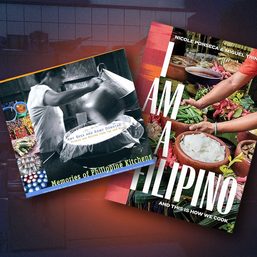SUMMARY
This is AI generated summarization, which may have errors. For context, always refer to the full article.
![[Kitchen 143] Learning to #LoveLokal with The Maya Kitchen’s cooking classes](https://www.rappler.com/tachyon/2022/06/mayakitchen.jpg)
Since 1964, The Maya Kitchen has been an institution providing love and flavor to the tables of Filipino families. Whether by making things easier for novice home cooks, or leveling up the skills of kitchen connoisseurs, this mainstay in the food industry has provided countless opportunities for exploration, learning, and bonding in the hearth of the home.

In their most recent cooking class, Pagkaing Lokal with Chef Cocoy Ventura, my daughter Gia and I learned fascinating tidbits on how to make delicious regional dishes with simple ingredients, all found locally.

Excited to learn more about our culture through food, both Gia and I looked forward to spending time in the kitchen together, while getting to know some of the other ladies who joined the cooking class with us. Whenever we get into the kitchen with others, it’s always an enriching experience where we enjoy learning from the experts and our fellow foodies cooking alongside us as well.

Small class sizes, readily available ingredients, and opportunities to learn in person and on Zoom offer variety for the learning styles of each individual. However, nothing beats being in the kitchen with a chef, especially when the chef is as charismatic and fun when educating his students as Chef Cocoy.

Hailing from the West Coast of California, Chef Cocoy wears more than one hat when in the kitchen. Professional chef-cum-documentary filmmaker, he highlights the rich beauty and diversity of Filipino food and culture through Ilocandia. An advocate of #lovelokal and proudly Pinoy dishes, Chef Cocoy shared where to buy authentic ingredients, delightful shortcuts in preparing these dishes at home, and the heritage behind Asin Tibuok, as his students followed the processes of each dish in the iconic teaching studio of The Maya Kitchen.

Tiyula Itum is a beef stew that comes from Davao and looks similar in presentation to Dinuguan because of its rich dark color and layers of flavor. Stewed in its own juices, this beef dish is notable for the toasted burnt coconut aromatics, and is perfect with freshly steamed rice. This savory dish boasted spices and aromatics that leave just enough heat to keep me coming back for more.

I found myself daydreaming of the beach when our cooking teammates, Rose and Marelle, started preparing Binabayasang Alimango. The base for this seafood dish is the native tart and tangy guava and can even be adjusted by adding coconut milk at the end to finish. Steamed sugpo ,lobster, or even other shellfish would make for a tasty substitution for this Manila dish.

Pancit Cabagan seemed the most simple of all the dishes we prepared during our time together. Using a hearty pork broth, fresh noodles are highlighted with simple textures and toppings that compliment the springy starch. Pancit from Isabela is perfect for merienda or as a side dish.

As if these dishes rich with history were not enough, Chef Cocoy also shared how to make one of my favorite drinks/desserts. I have seen guinumis prepared a few different ways. The most delicious guinumis I have enjoyed is during the simple dates Nino and I would steal away for at Milky Way on Pasay Road. This refreshing drink becomes a scrumptious dessert when you top it with a scoop of ice cream. Layers of shaved ice, rich coconut milk, tapioca, and gulaman are topped with toasted pinipig making for a delightful treat on any day when you need a pick me up.
Surely Gia and I will be adding all of these dishes to our regular rotation for #TeamGellibean’s dining table.

Tiyula Itum
INGREDIENTS:
1 kilo beef brisket (kampto) cut into 1 inch cubes
½ c of grated coconut meat
4 stalks of lemongrass, white section only pounded and tied neatly in a knot
3 pieces birds eye chili sliced open
4 c beef stock
1 piece thumb sized ginger, thinly sliced
½ piece thumb sized turmeric thinly sliced
6 cloves garlic minced
3 pieces shallots thinly sliced
Salt and pepper to taste
Canola oil for browning meat
PROCEDURE:
- In a dry pan set on medium to high heat, toast the coconut meat. The “burnt” coconut meat is what gives the dark rich color to the stew, so you should be toasting about 80% of the meat to a dark brown color. Once toasted, pulse in the food processor and set aside.
- Season the beef with salt and pepper and brown in a pot on high heat. After browning the beef cubes in batches remove the beef and set aside.
- In the same pot where you browned the meat, add a bit more oil to saute the aromatics. Add garlic, shallots, ginger, turmeric, and chilies. After these ingredients, add the burn coconut powder.
- Add the browned beef cubes with all the beef juices, lemongrass and beef stock to the pot. Bring to a boil and then simmer until the meat is fork tender on low heat. (about 1 ½ hrs.)
- If you like your stew spicy, cook it all the way through with chilies intact. If you just like a little bit of heat, you can remove the chilies half way through the cooking time. (We did this, and it was the perfect amount of heat without being uncomfortable.)
- Season with salt and pepper and serve with hot rice.
If you would like to attend the Filipino-themed cooking classes at the end of every month, contact The Maya Kitchen. You can also check out Instagram and Facebook for upcoming opportunities to share the kitchen love. – Rappler.com
Add a comment
How does this make you feel?


![[Kitchen 143] Winner winner, turkey dinner](https://www.rappler.com/tachyon/2023/09/turkey-dinner.jpg?resize=257%2C257&crop=276px%2C0px%2C720px%2C720px)
![[WATCH] Food Secrets: The origins of Paella Valenciana](https://www.rappler.com/tachyon/2023/04/food-secrets-paella-valenciana.jpg?resize=257%2C257&crop=407px%2C0px%2C1046px%2C1046px)
![[WATCH] Try This: Koshary from Egypt](https://www.rappler.com/tachyon/2023/04/try-this-koshary-egypt.jpg?resize=257%2C257&crop=160px%2C0px%2C1045px%2C1045px)
There are no comments yet. Add your comment to start the conversation.